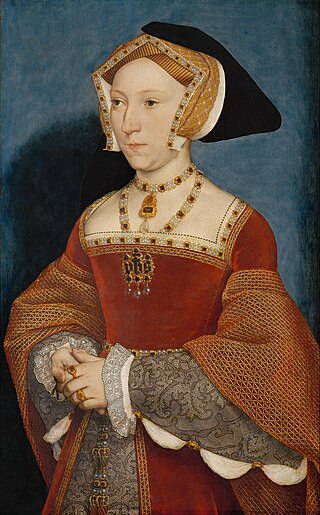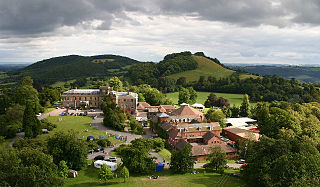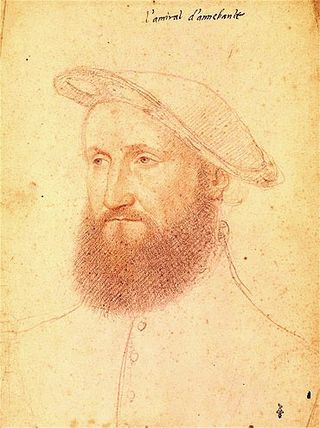Related Research Articles

Jane Seymour was Queen of England as the third wife of King Henry VIII of England from their marriage on 30 May 1536 until her death the next year. She became queen following the execution of Henry's second wife, Anne Boleyn. She died of postnatal complications less than two weeks after the birth of her only child, the future King Edward VI. She was the only wife of Henry to receive a queen's funeral or to be buried beside him in St George's Chapel, Windsor Castle.
Edward Foxe was an English churchman, Bishop of Hereford. He played a major role in Henry VIII's divorce from Catherine of Aragon, and he assisted in drafting the Ten Articles of 1536.

The Palace of Whitehall at Westminster was the main residence of the English monarchs from 1530 until 1698, when most of its structures, except notably Inigo Jones's Banqueting House of 1622, were destroyed by fire. Henry VIII moved the royal residence to White Hall after the old royal apartments at the nearby Palace of Westminster were themselves destroyed by fire. Although the Whitehall palace has not survived, the area where it was located is still called Whitehall and has remained a centre of government.

St James's Palace is the most senior royal palace in London, the capital of the United Kingdom. The palace gives its name to the Court of St James's, which is the monarch's royal court, and is located in the City of Westminster in London. Although no longer the principal residence of the monarch, it is the ceremonial meeting place of the Accession Council, the office of the Marshal of the Diplomatic Corps, as well as the London residence of several members of the royal family.
John Stokesley was an English clergyman who was Bishop of London during the reign of Henry VIII.
Henry Grey, 1st Duke of Suffolk, 3rd Marquess of Dorset, was an English courtier and nobleman of the Tudor period. He was the father of Lady Jane Grey, known as "the Nine Days' Queen".

Abberley is a village and civil parish in north west Worcestershire, England.

William Walsh of Abberley Hall, Worcestershire was an English poet and critic and a Whig politician who sat in the English and British House of Commons from 1698 to 1708.

Kirton in Lindsey, also abbreviated to Kirton Lindsey, is a market town and civil parish in North Lincolnshire, England. It is 7 miles (11 km) south-east from Scunthorpe.

Abberley Hall is a country house in the north-west of the county of Worcestershire, England. The present Italianate house is the work of Samuel Daukes and dates from 1846 to 1849. Since 1916 it has been occupied by Abberley Hall School. It is a Grade II* listed building. The gardens are listed as Grade II on the English Heritage Register of Historic Parks and Gardens of Special Historic Interest in England. In the area close to Stourport-on-Severn there are several large manor and country houses, among which Witley Court, Astley Hall, Pool House, Areley Hall, Hartlebury Castle and Abberley Hall are particularly significant.

A kirtle is a garment that was worn by men and women in the Middle Ages. It eventually became a one-piece garment worn by women from the late Middle Ages into the Baroque period. The kirtle was typically worn over a chemise or smock, which acted as a slip, and under the formal outer garment, a gown or surcoat.
Events from the 1530s in England.
George Cromer was Archbishop of Armagh and Primate of All Ireland in the reign of Henry VIII of England, from 1521/2.

The artists of the Tudor court are the painters and limners engaged by the monarchs of England's Tudor dynasty and their courtiers between 1485 and 1603, from the reign of Henry VII to the death of Elizabeth I.

Claude d'Annebault was a French military officer; Marshal of France (1538–52); Admiral of France (1543–1552); and Governor of Piedmont in 1541. He led the French invasion of the Isle of Wight in 1545. Annebault was governor of Normandy and a very powerful figure during the reign of King Francis.

Thomas Grey, 2nd Marquess of Dorset was an English peer, courtier, soldier and landowner of the House of Grey.
Abberley Hall School is a coeducational preparatory day and boarding school with about 160 pupils. It is located between Worcester and Tenbury, near the village of Abberley, Worcestershire, England.
Events from the year 1530 in Ireland.
George Walsh was an English politician, who served as MP for Eye 1680–1681.
John Kynton was an English 16th-century Franciscan friar, divinity professor, and a vice-chancellor of the University of Oxford.
References
- ↑ David Starkey, Six Wives:The Queens of Henry VIII, Vintage Publishing, 2004, p.430
- ↑ George Griffith (1852). "Abberley Free School". The Free Schools of Worcestershire and Their Fulfilment.
- ↑ WALSH, William (1662-1708), of Abberley, Worcs. and 'The Mews', nr. St. Martin's Lane, Covent Garden, Mdx., The History of Parliament